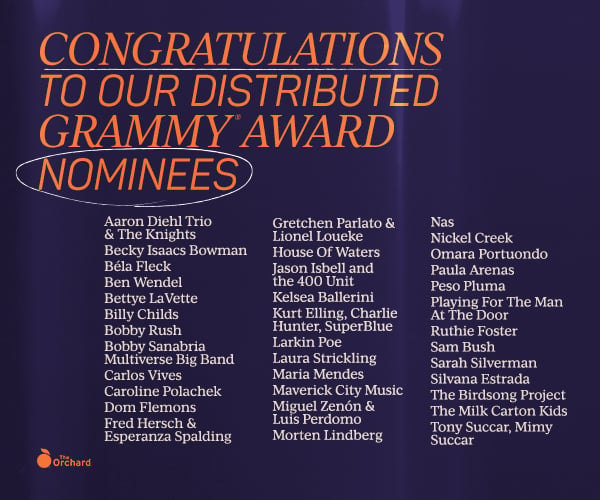The following MBW op/ed comes from PPL CIO Mark Douglas. Below, he turns his attention, and bullshit detector, to the much-hyped but little-understood world of NFTs. It’s fair to say he has some questions…
In my last column, I tackled the subject of Blockchains and their relevance to the music industry. I wrote that piece with a degree of apprehension, aware that I was poking the nest of a vocal and passionate crypto community.
As it happens, that article garnered nothing but positive feedback, with many grateful that the topic had finally been explained in terms they understood, and that the emperor had at last been called out for his lack of clothing. Emboldened by this feedback, I’m going to dial it up a notch and dig into the topic de nos jours, NFTs.
NFTs have quickly (briefly?) become a multi-billion dollar thing (I hesitate to call it an industry), and there are a lot of heavily vested interests with loud voices.
For some creators, NFTs have been a godsend, a new way to generate revenue, and I certainly want to have no part in interfering with an artist’s opportunity to monetise their talents. To that end, I’m going to do what many commentators fail to do, and de-couple the revenue opportunity/fan engagement aspects of NFTs from the actual technology and mechanics that underpin them. By doing so I hope to show that the two are not mutually dependent and draw attention to the many risks of NFTs.
Let’s start with the phrase itself – Non-Fungible Token. Many discussions on NFTs start with an explanation of fungibility. It’s a word/concept I first heard back in the late eighties as part of my Chartered Accountancy training. For a long time, the word wasn’t really used outside the finance and accounting community.
It’s a fairly typical trick of the crypto industry to use arcane, professional terminology to add legitimacy to their latest offering: ‘immutability’, ‘ledger’, ‘dis-intermediation’ – lots of serious sounding words, but ultimately their use is akin to a politician quoting public school Latin to try and convince you they are intelligent, when in fact all they have is a good memory.
At its simplest, a fungible asset is one that can be readily substituted by another. An ounce of 9-carat gold is a fungible asset because any one ounce has the same value as any other. Non-fungible assets, on the other hand, are unique and have a value that is unique to them. Whilst an ounce of gold may be fungible, a gold bar may not be, as the presence of hallmarks affords any one bar a special value to a collector due to its provenance.
One way to think of NFTs is to liken them to this gold example. At their simplest NFTs seek to add those Hallmarks to digital assets that are in all other regards fungible. Whilst the shift to digital has been very liberating, it has also had a very negative impact: due to being expressed as nothing but a sequence of ones and zeroes, any one digital asset is literally identical to any copy of it.
When your primary output as a creator is a digital asset, it is all but impossible to create differential value in any one copy. Whilst special extended mixes or remixes can be created and sold at a premium, the ease with which exact copies can be made and distributed globally undermines the ability to create proper value. Mechanisms such as Digital Rights Management have been deployed in the past to try and prevent this widespread copying, but they put too many barriers in the way for legitimate consumers and ultimately failed.
“You can do much, if not all, that an NFT can do in much simpler ways.”
So how do you create that uniqueness in an otherwise fungible item? How do you create the digital equivalent of that limited edition, blue vinyl pressing of ELO’s Out Of The Blue that caused much excitement on my school bus back in 1978? The NFT solution to this is to produce not a special version of the asset, but to create a tamper-proof till receipt (I actually now think of the T in NFT as meaning exactly that).
But I’m getting ahead of myself. Let’s back up a bit and look at the mechanics of NFTs, because things should then become clearer.
At the heart of NFTs are blockchains. As covered in my last article, blockchains are all about providing a tamper-proof, public ledger of data. Step one of generating an NFT is to add a ‘smart contract’ onto a blockchain.
If you are imagining that a large, wordy document full of legalese has just been created, you would be mistaken. As it happens, a smart contract is neither particularly smart, nor a contract.
A smart contract is lines of computer code that specify some basic rules to follow when someone wishes to transact through that contract – rules to determine whether any inventory is available, to calculate the unit price and issue a purchase receipt. Think of it as a robotic checkout assistant and you’ll be nearer the mark. In practical terms, a smart contract is a series of ‘if/when…then…else’ statements along with some arithmetic operations, like you would see in a standard spreadsheet.
The crypto world loves smart contracts because they further their ideological pursuit of removing the middleman from the making and recording of transactions.
The role of a smart contract in the world of NFTs is to determine the availability of the item for sale, to compute the price payable, and to ensure that (cryptocurrency) payment is made. The smart contract then creates the actual NFT token by creating a new entry on the blockchain, in a process known as ‘minting’.
Contained within that token is typically little more than the ID of the contract that created it, the crypto identity of the buyer and a unique identifier. You will note that the actual digital asset that was being ‘purchased’ is not in that list of items.
There is a good reason for that. Adding data to blockchains is an expensive process (literally hundreds of dollars per transaction, depending on the prevailing value of the relevant cryptocurrency), and the cost increases with the amount of data you are trying to add. So the NFT is, by necessity, as small as it can possibly be. It’s a till receipt with a serial number, the price paid, and the digital wallet identifier of the buyer.
But we’re not finished yet. There are still more steps involved in getting to the digital asset. The first of these is to use the ID held in the NFT, along with data from the smart contract that minted it, to generate a URL to a small data file somewhere out on the internet. That file (technically a small JSON format file) contains the name of the item that has been ‘purchased’, a description of the item and, finally, the actual URL that links to the digital asset.
Why have I gone to these lengths to explain how NFTs work? Firstly, I think doing so makes it clear that what is actually being sold is nothing more than a glorified till receipt. A till receipt that proves you were willing to pay for something that in most regards is freely available to all. Whilst the NFT itself is non-fungible, the asset to which it directs you is not and, to that end, NFTs create an artificial sense of scarcity.
Secondly, I think it will have come across that it’s a pretty convoluted way of doing things. You can do much, if not all, that an NFT can do in much simpler ways. British Airways and Hilton Hotels have been offering privileged access to their lounges and the like for three decades or more with not an NFT in sight. Eventbrite and Ticketmaster have been granting VIP access to concerts and backstage access for years.
But my issues with NFTs don’t end there. With its total reliance on crypto technology, possession of the digital keys is instrumental if you are to derive any value from the purchase in the future. Lose access to your digital wallet and you have likely lost every NFT you have purchased. Ask the chap in Newport how it feels to know that the keys to your prized crypto possessions are on a hard disk, buried somewhere in the middle of a landfill site…
“As it happens, a smart contract is neither particularly smart, nor a contract.”
Compounding this technology risk, there is no one standard for NFTs. There are literally hundreds of NFT marketplaces, and they all adopt slightly different approaches and use different underlying platforms. Many rely on the Ethereum blockchain, but not all.
The long-term viability of the underlying technology is critical if the buyer is to derive value in the future. Whilst they may still have access to the digital asset, as set out earlier, the value lies in the provenance provided by the blockchain-based receipt. If that blockchain ceases to exist, the value in the NFT disappears with it.
If these technology risks are managed, a further cause for concern is that trading in NFTs requires the buyer to embrace cryptocurrencies. As well as exposing them to all the price volatility risk that this entails, it is potentially discriminatory in that it denies access to those of lower economic standing.
These things in combination cause me to question whether this is the right way to engage with and monetise a loyal fanbase. The NFT landscape is a complex place with a great deal of marketing spin and hyperbole. If you are thinking about getting on board with NFTs, are you doing it for the right reasons, and have you thought through the long-term implications for your brand and for your fans? Or are you being played by big money backers that are desperate for their NFT platform to succeed?
You see, as I covered in my Blockchain piece in the last issue, the ideological objective of removing the middleman is a fiction; your average creator has no more chance of creating a smart contract and uploading it to a Blockchain than flapping their arms and flying.
There is a reason that marketplace platforms like OpenSea and SuperRare have risen to prominence. Someone needs to be there with the tools and templates to make it all happen. Middlemen they are, and they charge a fee for their services, just like traditional third-party service providers. Becoming established as one of the leading platforms is a high-stakes game with some very big players. Are creators being used as cannon fodder in this game?
“NFTs have become a multi-billion dollar thing and there are invested interests with loud voices.”
But above all, my issue with NFTs is that in the rush to jump on the bandwagon, the ‘creative’ space has become littered with people generating art and music with little to no effort – throwing random datasets at artificial intelligence routines and leaving them to come up with whatever.
This pains me, as it fundamentally devalues the creative process. When Geraint Thomas recently tried to launch an NFT of computer-generated art based on the power data from some of his biggest career wins, he was met with general derision from his fanbase and the wider cycling community. I fear not all fan bases are so clear in their feedback and get duped by those seeking to make a quick buck. I personally don’t think that’s a good look for the music industry.
Don’t get me wrong, I know that monetising talent in this overcrowded digital world is difficult. And there are many aspects of NFTs that I find intellectually stimulating. If the buyer of an NFT genuinely understands what they are buying, and the risks they are taking, then who am I to question whether or not there is real value in what they have purchased.
I can question all I like why someone would pay potentially millions of dollars for a glorified till receipt that gets you access to the very same item that the rest of the world can have for free. But is this any different from a collector spending hundreds of thousands of pounds on a designer brand Swiss chronometer that will likely have cost only a few hundred pounds to manufacture and tells the time no better than a £5 digital watch?
The reality is that the value of something is not a matter of fact. An item is worth what someone is willing to pay for it. As people spend more of their lives in digital worlds, perhaps it does make more sense to have a digital bragging token than a fancy car or watch that very few will ever see. In closing, and to quote my own bit of Latin, perhaps the real answer to all of this is simply caveat emptor.
MBUK is available via an annual subscription through here.
All physical subscribers will receive a complimentary digital edition with each issue.Music Business Worldwide






